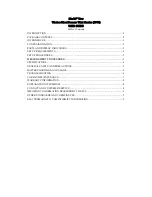
3
BP B1 Classic
EN
6. The result, comprising the systolic
AT
and the diastolic
AK
blood
pressure and the pulse rate
AL
is displayed. Note also the
explanations on further display symbols in this booklet.
7. When the device has finished measuring, remove the cuff.
8. Switch off the device. (The monitor does switch off automati-
cally after approx. 1 min.).
You can stop the measurement at any time by pressing the
ON/OFF button (e.g. if you feel uneasy or an unpleasant
pressure sensation).
Manual inflation
In case of high systolic blood pressure (e.g. above 135
mmHg)
, it can be an advantage to set the pressure individually.
Press the ON/OFF button after the monitor has been pumped up
to a level of approx. 30 mmHg (shown on the display). Keep the
button pressed until the pressure is about 40 mmHg above the
expected systolic value – then release the button.
How not to store a reading
As soon as the reading is displayed press and hold the ON/OFF
button
1
until «
M
»
AO
is flashing. Confirm to delete the reading by
pressing the time button
4
.
«
CL
» is displayed when the reading is deleted from the
memory successfully.
How do I evaluate my blood pressure?
The triangle on the left-hand edge of the display
AN
points at the
range within which the measured blood pressure value lies. The
value is either within the optimum (white), elevated (hatched gray)
or high (black) range. The classification corresponds to the
following ranges defined by international guidelines (ESH, ESC,
JSH). Data in mmHg.
The higher value is the one that determines the evaluation.
Example: a blood pressure value of
140/80
mmHg or a value of
130/90
mmHg indicates «blood pressure too high».
Appearance of the Pulse Arrhythmia (PAD)
This symbol
AS
indicates that certain pulse irregularities were
detected during the measurement. In this case, the result may
deviate from your normal blood pressure – repeat the measure-
ment. In most cases, this is no cause for concern. However, if the
symbol appears on a regular basis (e.g. several times a week with
measurements taken daily) we advise you to tell your doctor.
Please show your doctor the following explanation:
4. Data Memory
This device automatically stores the last 30 measurement values.
Viewing the stored values
Press the M-button
3
briefly, when the device is switched off. The
display first shows «
M
»
AO
and «
A
», which stands for the average
of all stored values.
Pressing the M-button again displays the previous value. Pressing
the M-button repeatedly enables you to move from one stored
value to another.
Blood pressure readings with suboptimal cuff fit
AQ
-A are
not considered in the average value.
Pay attention that the maximum memory capacity of 30
memories is not exceeded.
When the 30 memory is full,
the oldest value is automatically overwritten with the 31
value.
Values should be evaluated by a doctor before the
memory capacity is reached – otherwise data will be lost.
Clearing all values
If you are sure that you want to permanently remove all stored
values, hold down the M-button (the device must have been
Range
Systolic Diastolic Recommendation
1. blood pressure
too high
≥
135
≥
85
Seek medical
advice
2. blood pressure
elevated
130 - 134 80 - 84
Self-check
3. blood pressure
normal
<130
<80
Self-check
Information for the doctor on frequent appearance of the
Arrhythmia indicator
This device is an oscillometric blood pressure monitor that also
analyses pulse irregularity during measurement. The device is
clinically tested.
The arrhythmia symbol is displayed after the measurement, if
pulse irregularities occur during measurement. If the symbol
appears more frequently (e.g. several times per week on
measurements performed daily) we recommend the patient to
seek medical advice.
This device does not replace a cardiac examination, but serves
to detect pulse irregularities at an early stage.
































